Spring is abloom in shades of pink and turquoise
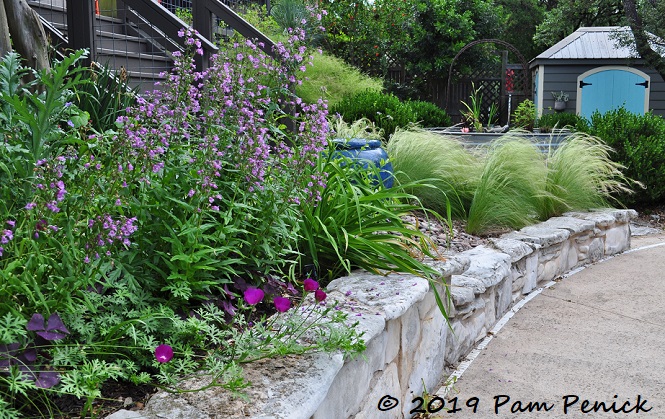
I haven’t done a photo tour of my own garden in a while, so let’s go, starting with a new planting of Gulf Coast penstemon (Penstemon tenuis) and winecup (Callirhoe involucrata), both Texas natives. Along with an artichoke — I’ve always wanted to try one — they’re enjoying some sun where a large Texas persimmon once shaded most of this bed.
The persimmon had been living on borrowed time for 10 years. From day one, I knew it was in the wrong spot, too close to the eave and tangling with a nearby live oak and crepe myrtle. But it was a beautiful tree, and I couldn’t bring myself to remove it — until I was forced to remove the dying live oaks. That day I took a saw to the persimmon for good measure. Farewell, persimmon! You served us well, but it was a case of wrong place, wrong plant, and you were too big to be squeezed into a narrow raised bed behind the house. Now other plants have room to breathe.
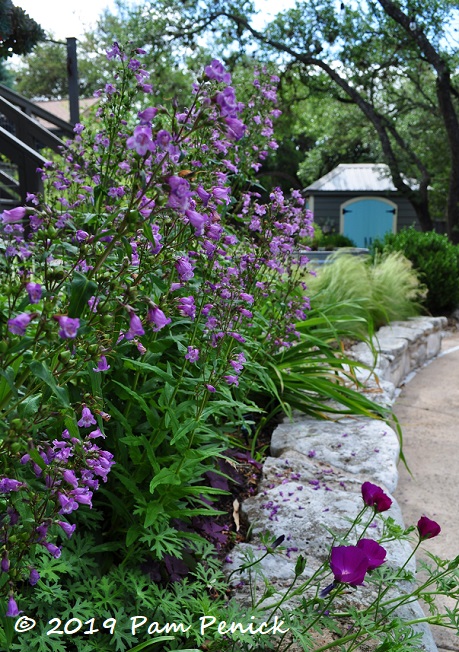
Bees are loving the Gulf Coast penstemon, which makes me happy.
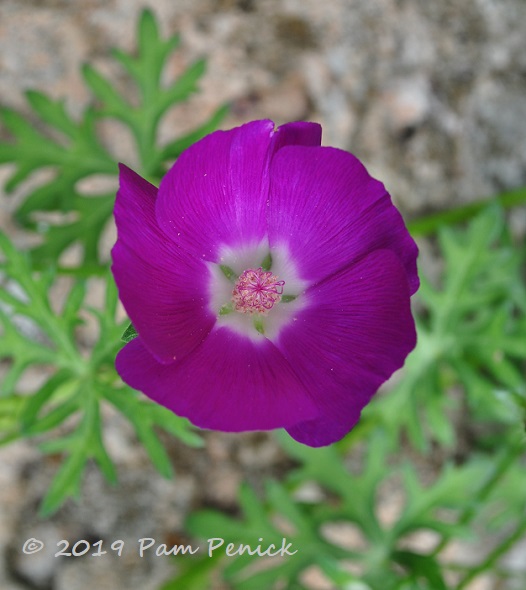
Winecup flower — simply lovely
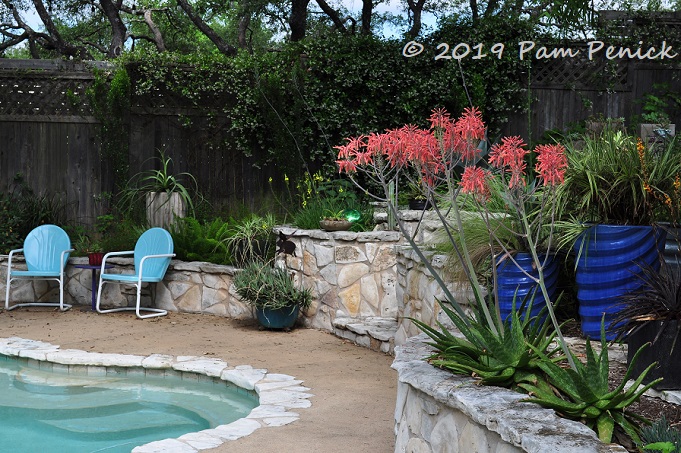
A trio of soap aloes (Aloe maculata) have sent up candelabra bloom spikes, also beloved by honeybees. These aloes are 10 years old, if you can believe it. I’ve kept them as solitary specimens by regularly culling the pups that appear around the base. Many of my friends have gone home with a few aloe pups.
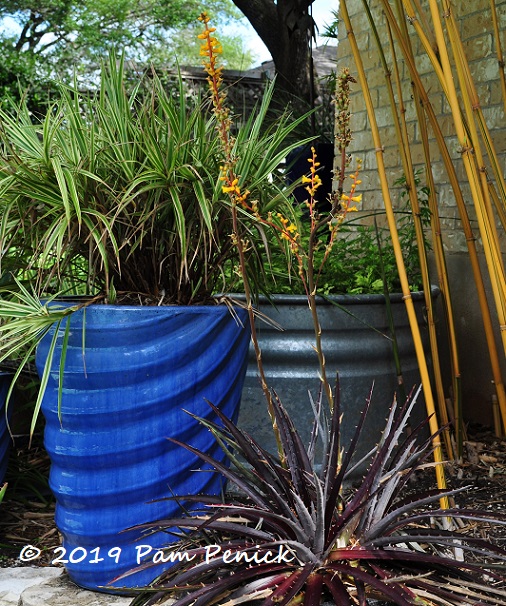
‘Burgundy Ice’ dyckia is also blooming, and that combo of frosty-eggplant leaves and creamsicle-orange flowers is one of my faves. Notice how the flowers echo the golden culms of ‘Alphonse Karr’ bamboo.
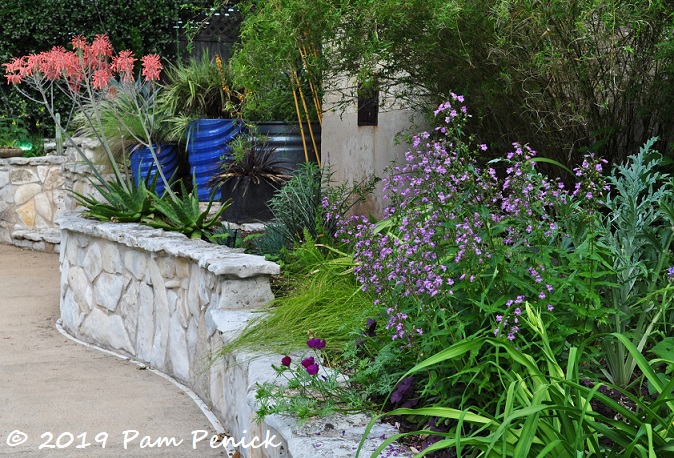
The long view. I powerwashed the limestone walls this spring, and what a difference it made. With all the black stains gone, it looks brand new.
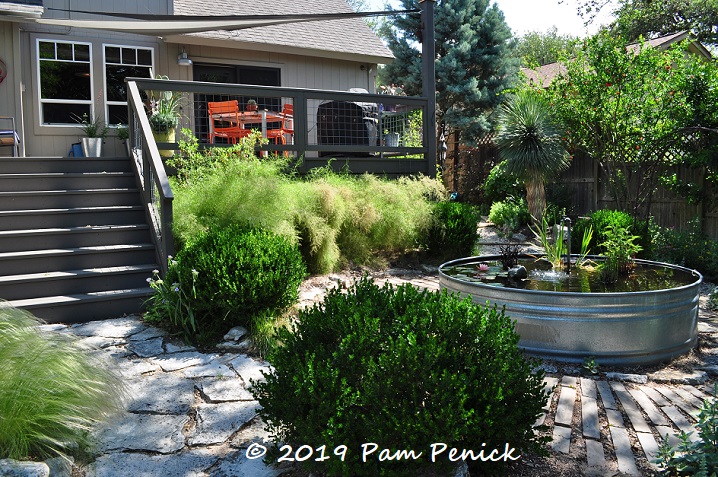
The bamboo muhly (Muhlenbergia dumosa) along the deck remained green all winter, dodging damage from that late freeze — woot! But I’m having some trouble with one of my ‘Winter Gem’ boxwood balls, the one pictured in the foreground. The interior has thinned out, and there are yellowing leaves in the center. It doesn’t look like boxwood blight to me, but I’m not sure what’s wrong. (There’s always something, am I right?)
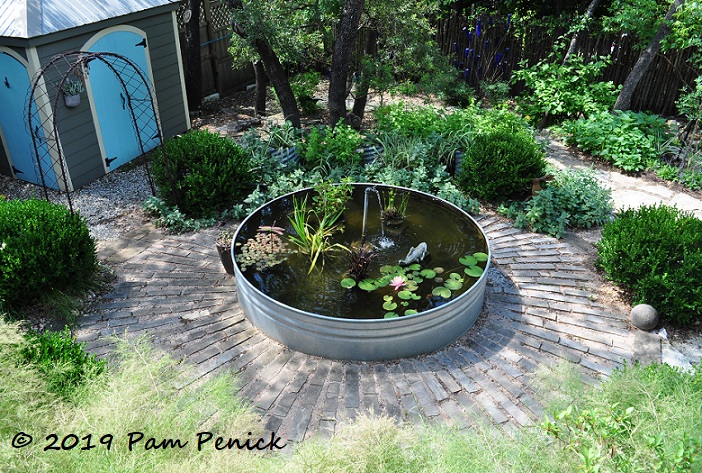
I would hate to lose the boxwoods that give such essential structure to my stock-tank pond garden.
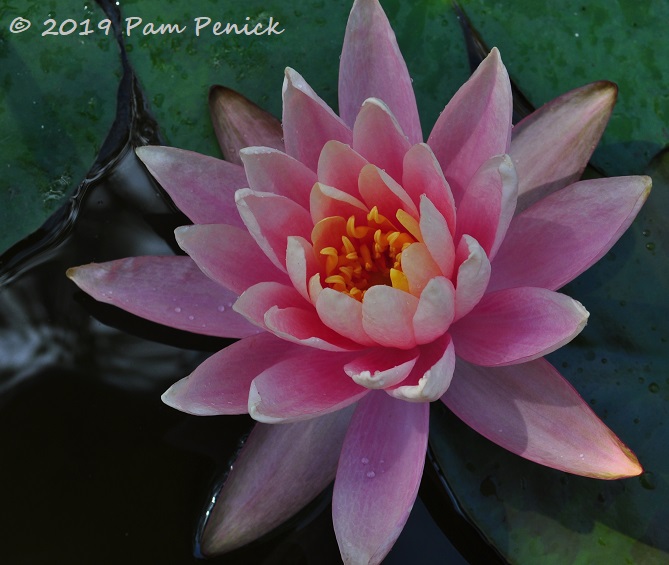
The pond plants are filling in again, and a few ‘Colorado’ waterlilies have already appeared. They are so lovely.
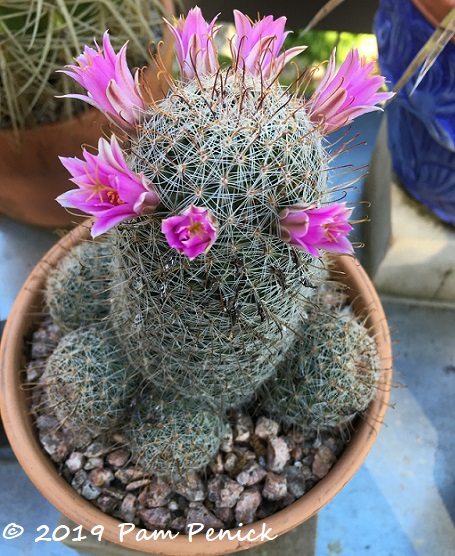
So too is a crown of pink flowers on a potted mammillaria cactus on the deck.
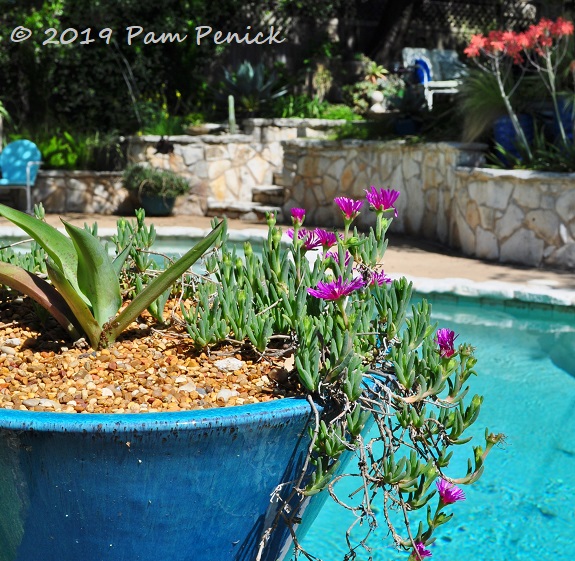
More pink! Ice plant blooms next to a baby ‘Macho Mocha’ mangave. (Look at that clean wall. Ahh.)
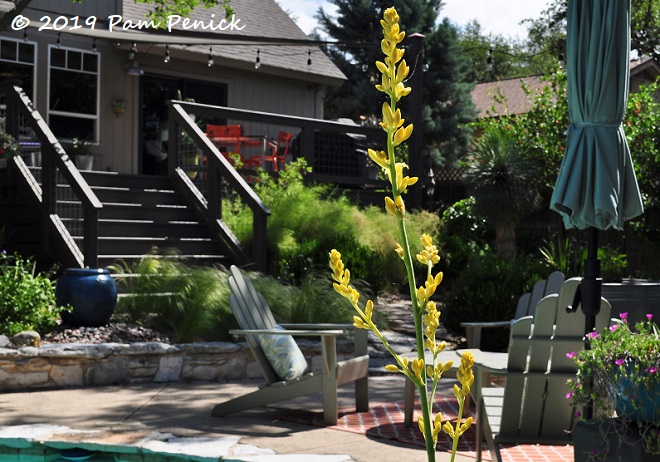
And butter-yellow wands of hesperaloe (Hesperaloe parviflora ‘Yellow’) are popping up behind the pool.
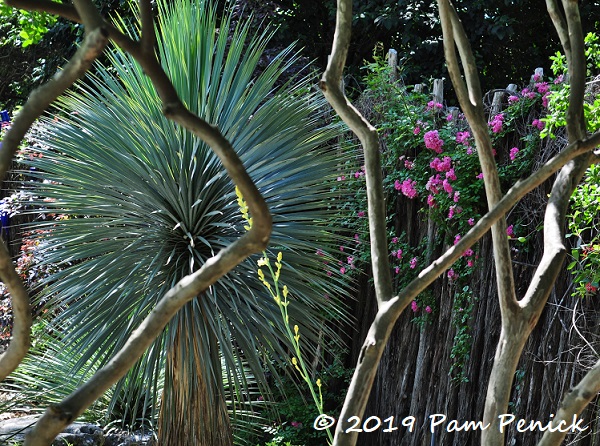
The sinuous trunks of two Texas persimmons make an interesting frame for a Yucca rostrata and Katrina rose on the back fence.
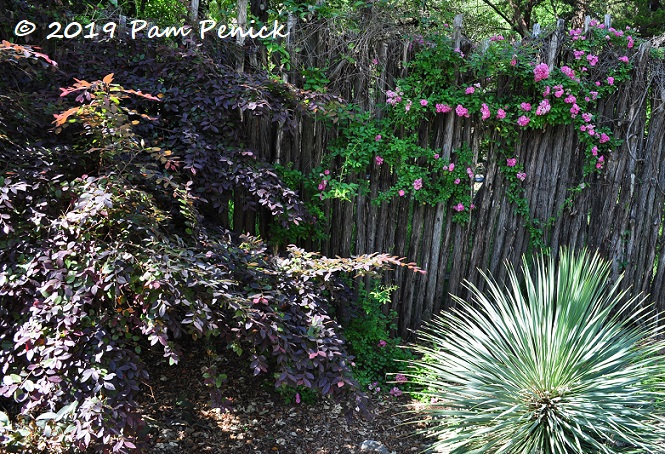
Those roses! I know it’s not much, but this is the most my Katrina rose has ever bloomed, no doubt due to two live oaks coming down and opening up a bit more sun, plus all the rain we’ve had this spring. It harmonizes nicely with the nearly black leaves of ‘Sizzling Pink’ loropetalum, which enjoys a shadier nook.
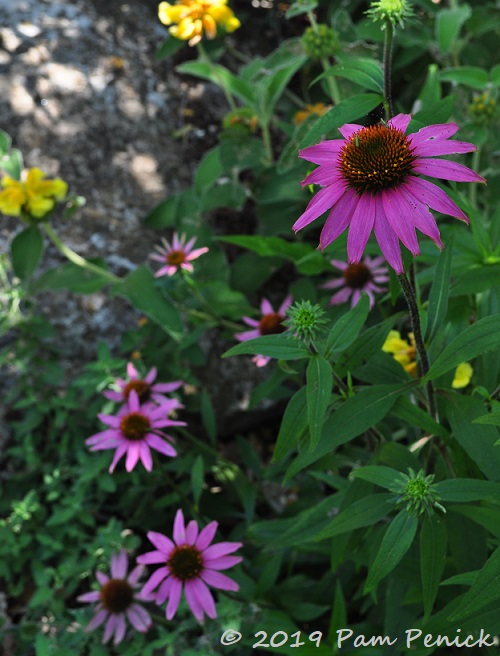
Purple coneflower (Echinacea purpurea) has started to bloom, with a few Jerusalem sage (Phlomis fruticosa) flowers wandering in.
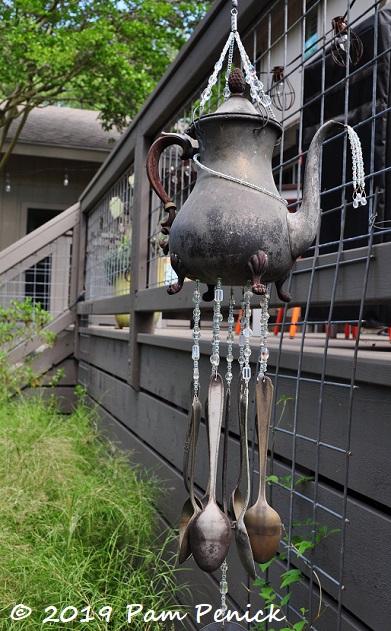
Tempest in a Teapot
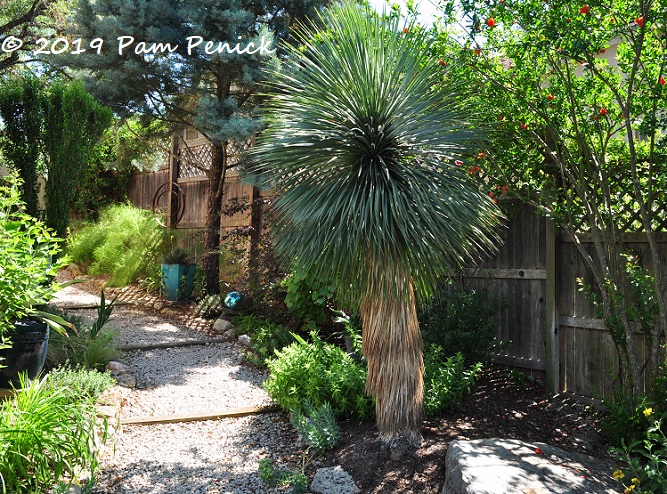
As we head uphill via the side-yard path, a ‘Sapphire Skies’ Yucca rostrata looms tall over the path. It’s taking on a distinct personality as it matures. ‘Wonderful’ pomegranate flowers at right. In the square blue pot halfway up the hill…
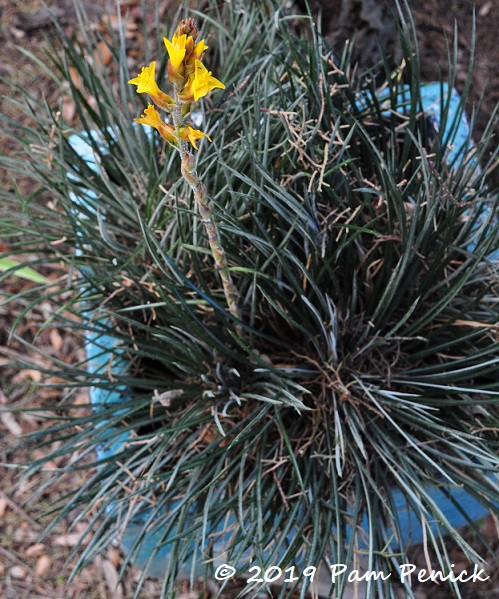
…’Frazzle Dazzle’ dyckia is flowering, a solitary golden yellow pennant.
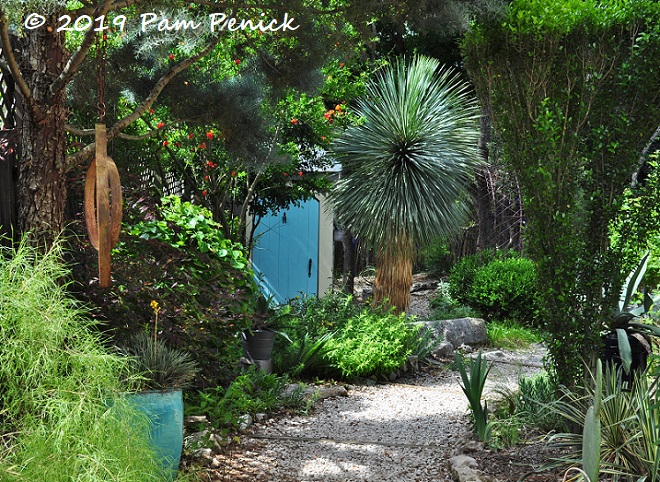
Looking back down the hill, the turquoise shed door picks up the pot color.
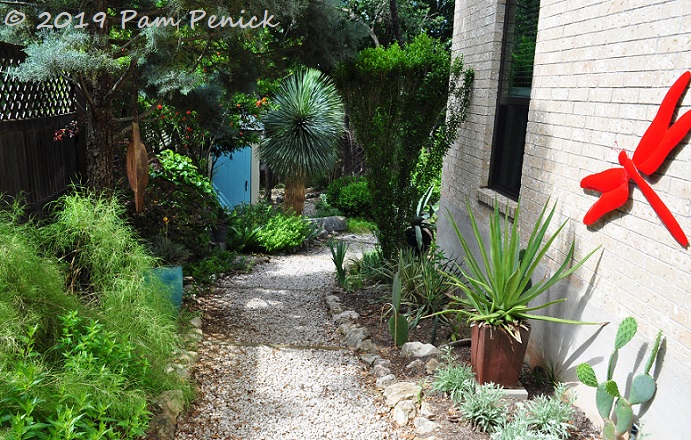
A wider view reveals a shade tunnel created by ‘Blue Ice’ Arizona cypress and ‘Will Fleming’ yaupon. This strip gets hot sun, but agave, yarrow, prickly pear, and bamboo muhly grow well with little attention.
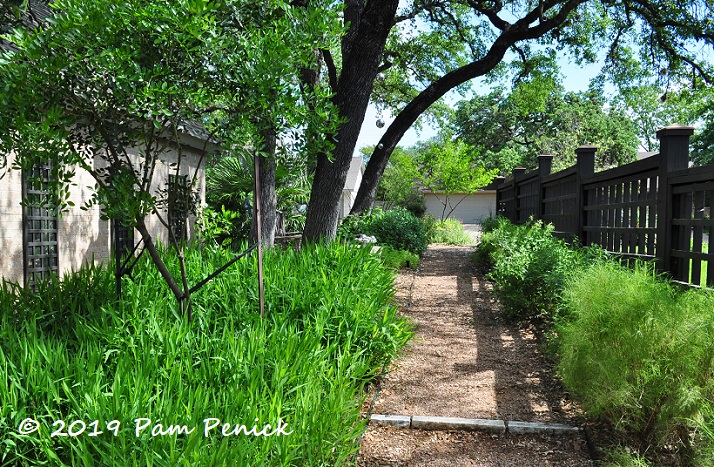
On the other side of the gate, you enter the deer-visited garden, so plant choices are grassy and herbal, with fibrous and/or fragrant leaves that deer don’t love. Under a Texas mountain laurel, inland sea oats (Chasmanthium latifolium) is unfussy and makes a lush, tallish groundcover. Sometimes a fawn will hide itself in here while its mother goes off to feed. On the right side of the path, bamboo muhly adds feathery texture, and shearing keeps it compact.
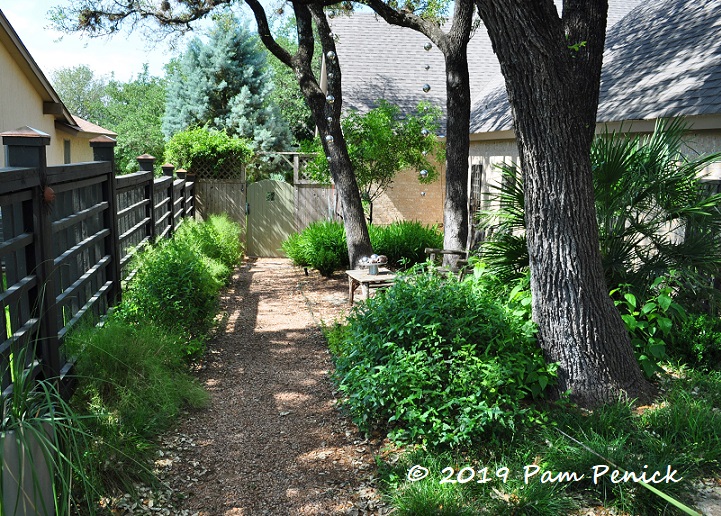
Here’s the view looking back down the path toward the gate. Under the live oaks, Brazilian rock rose (Pavonia hastata) blooms when the weather gets hot.
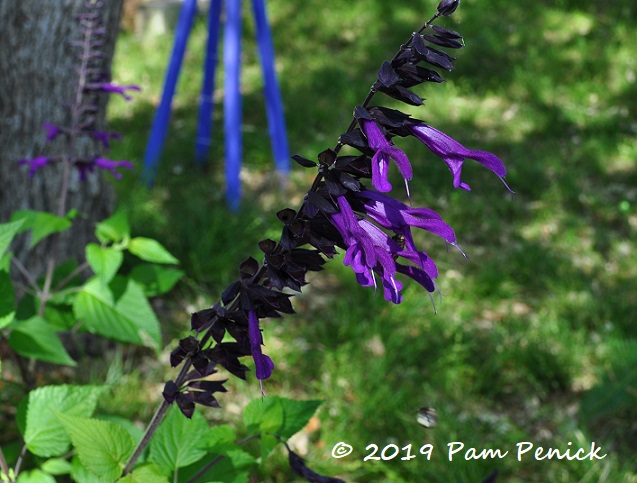
In the front garden, ‘Amistad’ salvia attracts bees and hummingbirds.
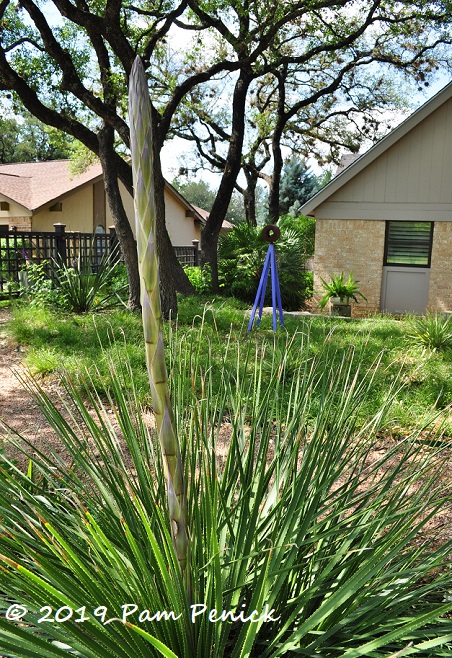
Texas sotol (Dasylirion texana) is sending up a spear-like bloom spike. Last year all my Texas sotols except this one bloomed, but at last it’s joining the fun. Beyond, Berkeley sedge (Carex divulsa) is a no-mow (almost; just once a year) lawn substitute.
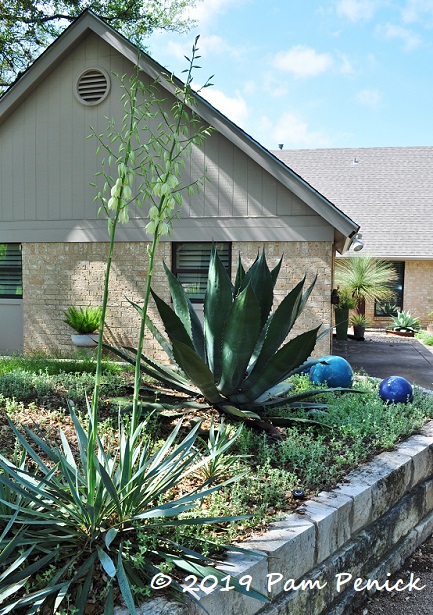
Paleleaf yuccas (Y. pallida) are blooming alongside ‘Green Goblet’ agave. The deer have eaten some of the bloom spikes, even though I sprayed them with deer repellent, but a few still remain.
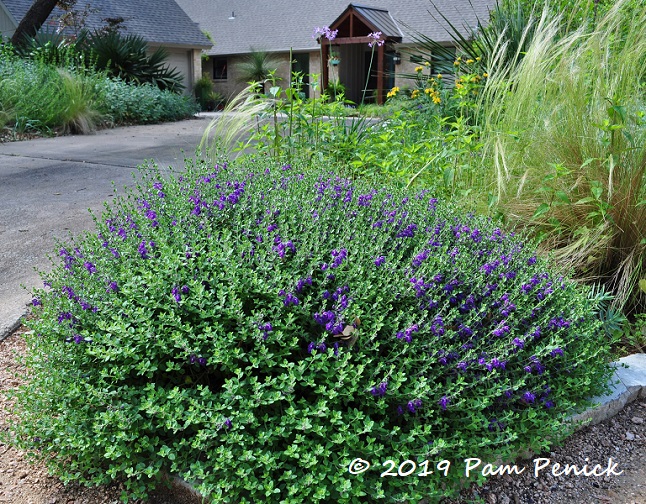
One of my favorite native plants is purple skullcap (Scutellaria wrightii), a tidy, green mound sprinkled with amethyst flowers. It grows in the hellstrip, in the hottest, driest, sunniest part of my yard, where every passing male dog lifts its leg. AND IT DOESN’T CARE.
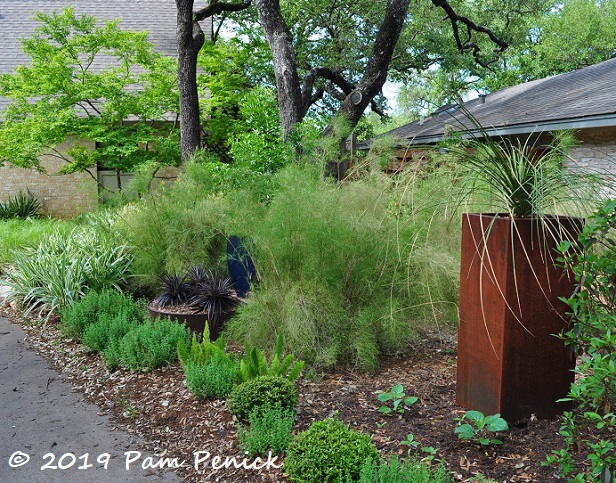
I’ve massed groups of tough, deer-resistant, shade-tolerant plants along the driveway: foxtail fern (Asparagus meyeri), ‘Micron’ dwarf yaupon holly, white skullcap (Scutellaria suffrutescens ‘White’), variegated flax lily (Dianella tasmanica ‘Variegata’), and bamboo muhly. A toothless sotol (Dasylirion longissimum) grows in the tall corten planter and will eventually become a shimmering sphere of strappy leaves.
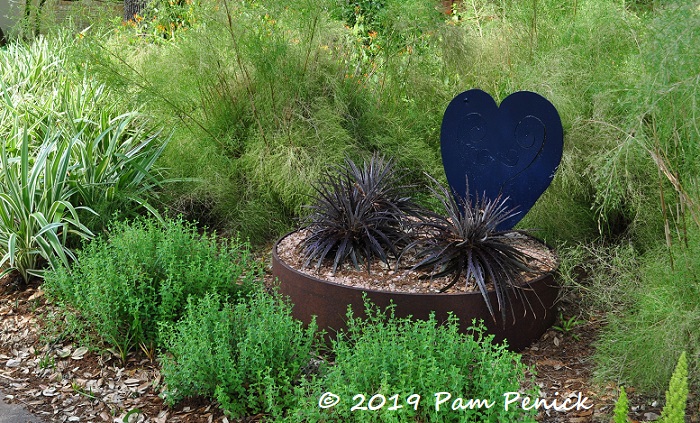
For contrast, I went goth in a section of steel pipe I’m using as a planter: three ‘Burgundy Ice’ dyckias and a steel heart painted midnight blue.
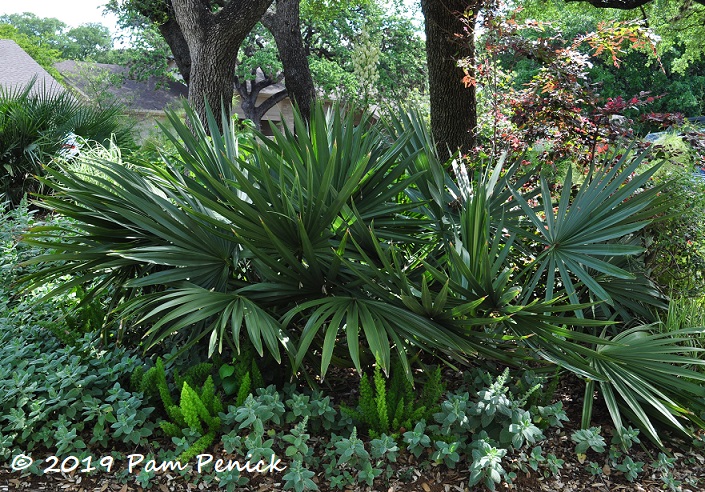
In the island bed in the middle of the driveway, three dwarf Texas palmettos (Sabal minor) are, with every year, less and less dwarf-like. I’m loving those long-fingered leaves. Heartleaf skullcap (Scutellaria ovata) will soon be flowering at the front of the bed.
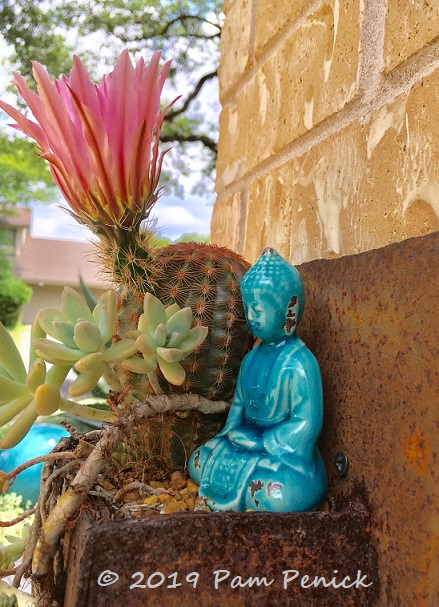
On the garage wall, a steel planter holds a Coahuila lace cactus (Echinocereus pectinatus var. coahuila) sporting a blossom as large as the plant itself.
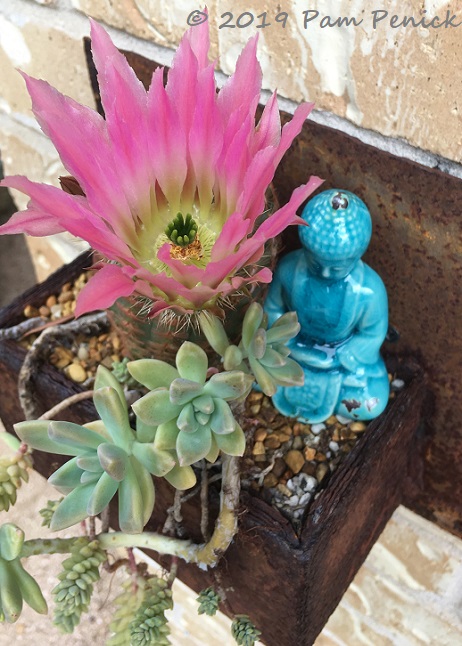
Shazam! There’s another bud as well, which I hope will hold off until this one is finished, extending the bloom time.
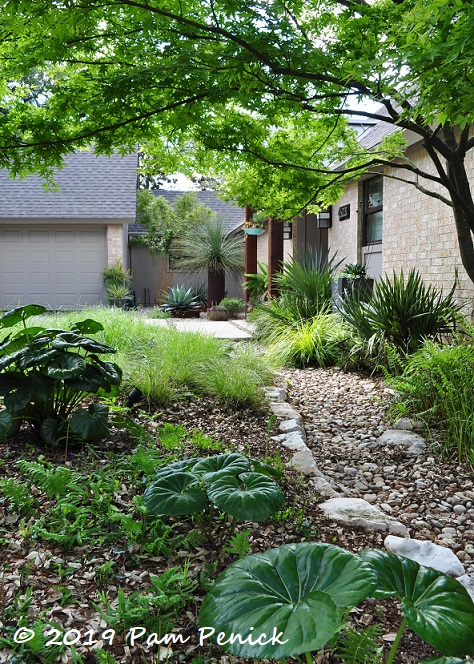
Since the deer decided, after 9 years of abstention, that our native river fern (Thelypteris kunthii) is a tasty treat, I looked around for a replacement and realized it was the perfect opportunity to try giant ligularia, aka leopard plant, aka tractor seat ligularia (Farfugium japonicum ‘Gigantea’). I’ve lusted after those round, glossy leaves for a while and noticed that deer don’t bother them in my neighborhood. But I assumed they were super thirsty. Well, I’m now giving them a try and will report again once they’re well established. They do need lots of shade, or they wilt alarmingly.
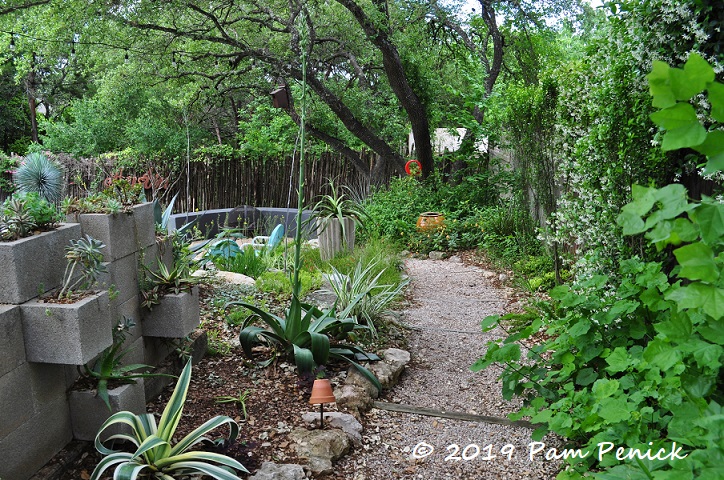
Through the gate and into the back garden again, the path leads past a small-succulent collection displayed in a cinderblock planter. Star jasmine (Trachelospermum jasminoides), sweetly fragrant, climbs the fence at right.
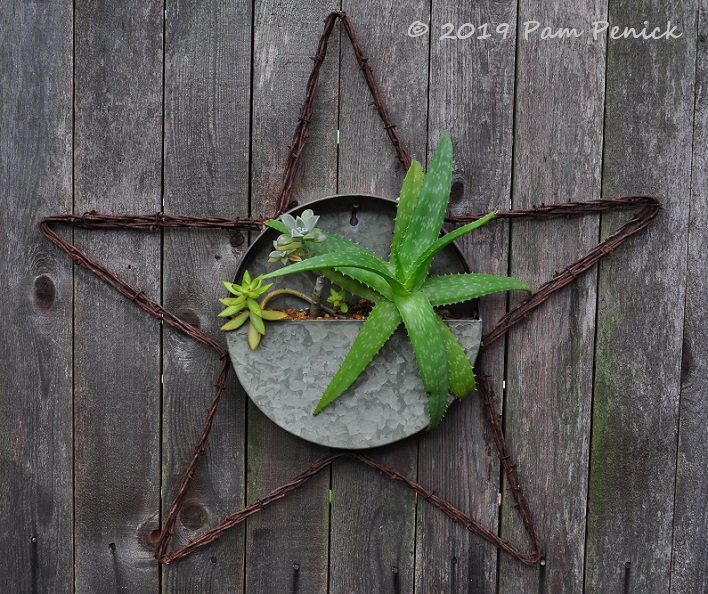
A barbed-wire star echoes the starry shape of a soap aloe in one of the “pie pan” wall planters.
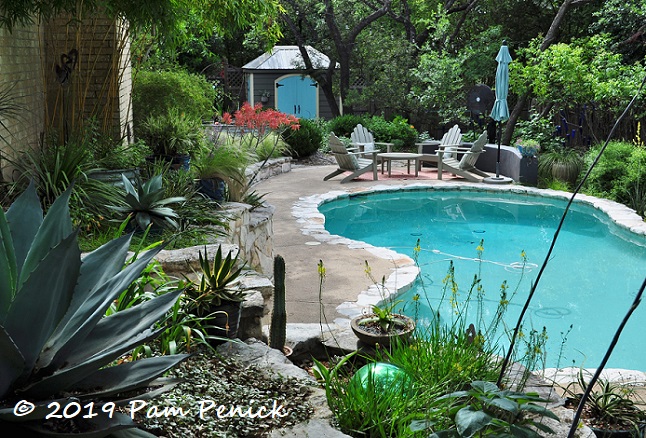
From the path you get a long view across the back yard. I switched out the red umbrella this year for a minty green one, the better to blend with all the blues. You can’t fight a view-dominating turquoise pool, I’ve learned. Better to play along.
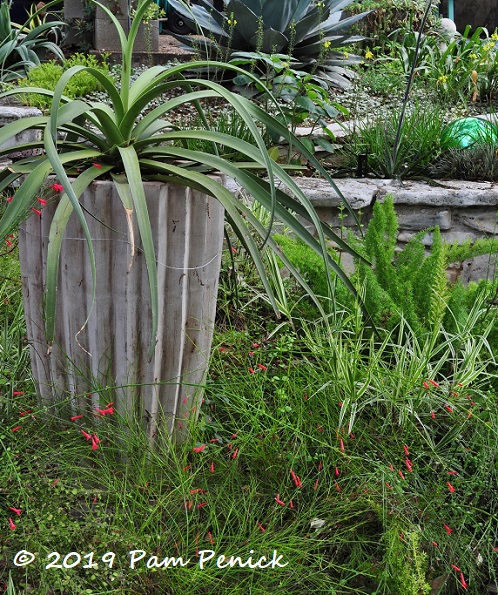
I also switched out a toothless sotol, which was going to grow too large for this fluted pot, for a wavy-armed squid agave (A. bracteosa). I dug up the squid from elsewhere in my garden, and he’s a perfect fit! The toothless sotol went to my friend Cat of The Whimsical Gardener, who wanted to try it in a pot in her side garden. I look forward to seeing how it works out for her.
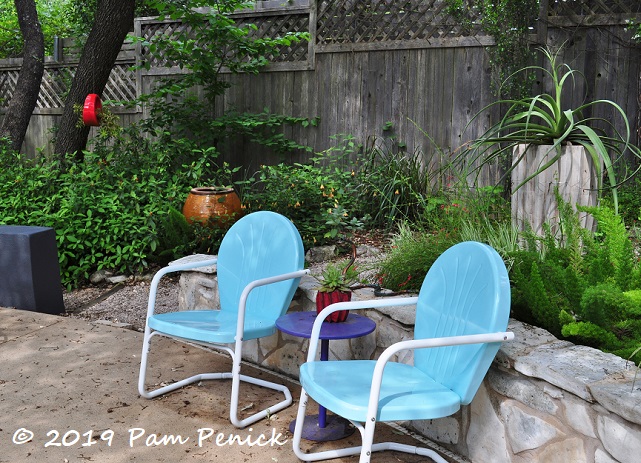
A wider view
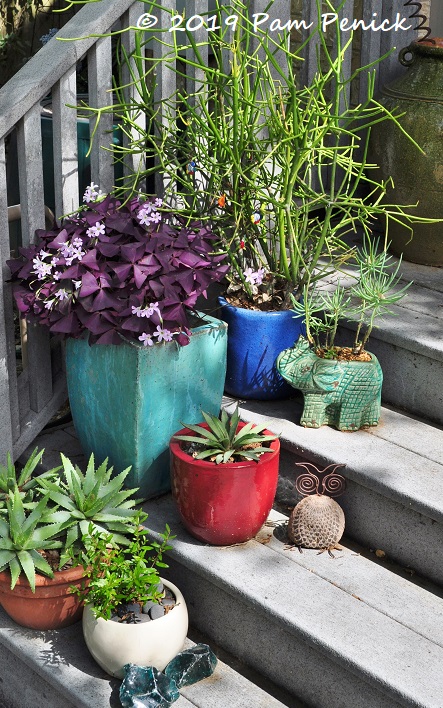
On the back steps of the house, I’m having fun with various colors of pots and shade-tolerant, low-maintenance plants. From top to bottom: ‘Sticks on Fire’ euphorbia, blue chalk fingers (Senecio vitalis), purple oxalis (Oxalis triangularis), ‘Bloodspot’ mangave, an unknown aloe, and a ‘Peppy Le Pom’ pomegranate I’m trialing from Spring Meadow Nursery.
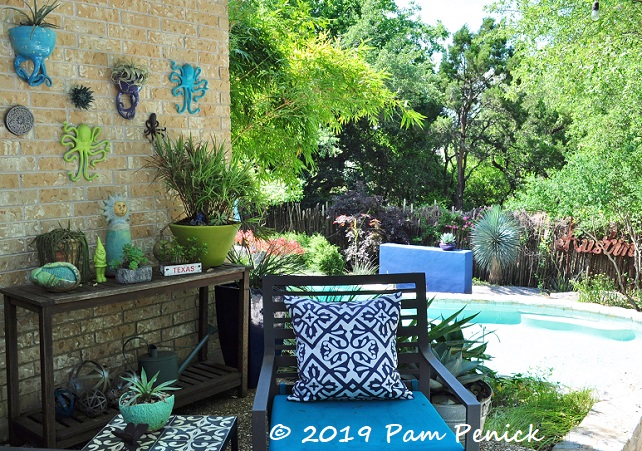
This patio enjoys welcome shade as we move into summer.
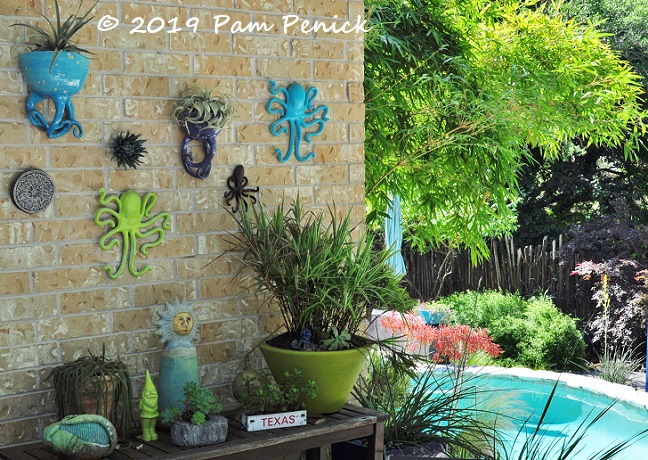
And the octopus wall planters and decor are goofy, poolside fun.
__________________________
Digging Deeper
Come learn about gardening and design at Garden Spark! I organize in-person talks by inspiring designers, landscape architects, authors, and gardeners a few times a year in Austin. These are limited-attendance events that sell out quickly, so join the Garden Spark email list to be notified in advance; simply click this link and ask to be added. Season 8 kicks off in fall 2024. Stay tuned for more info!
All material © 2025 by Pam Penick for Digging. Unauthorized reproduction prohibited.


My boxwoods suffer little damage but this year a few of my Green Gems and Green Mts. have brown spots. It is likely frost damage or burn from winter sun (at least up here in WI). My interiors are varying degrees of denseness. Unless it affects the look of the entire plant I don’t worry too much about that. But this year I am going to lose my last two boxwoods from Heronswood. They were cuttings from the gardens of Rosemary Verey and Winston Churchill. Less hardy varieties and the incredible cold did them in even with a lot of snow cover.
Oh no, that’s a loss, Linda. It sucks to lose a plant with history like that. I’m hoping my boxwood will shrug off whatever seems to be ailing it. I know it isn’t cold damage here in Austin. 🙂
Thank you for sharing all of your very beautiful garden. So much thought, landscaping talent, and beauty found here. Love the touch of blues and turquoise’s.
Thanks, Kay!
see, this is why I don’t bother taking photos when I visit: no need when yours are SO much better…
everything is gorgeous and glowing, no doubt because of the additional reflected light from the AMAZINGLY clean rock walls! please accept the compliments of a fellow power-washing aficionado.
It’s a dirty job but strangely satisfying. Next year I’ll be tackling the front walls. It’s like painting the Golden Gate Bridge: a new section every year, and it never ends.
Pam
Thank you so much for the tour of your gardens. It makes me miss some of the warmer zone plants and Texas natives. Love the layout, textures and plant selections…and the color!!!!!! Wowzers!
Thanks for the kind comment, Max!
Pam, I’ve never seen your garden looking this good! But yes, it’s always something. You could replace the boxwoods with dwarf yaupon if you lose them. And that wall…..wow!
Thank you, Peter. You’re right that dwarf yaupon would be a good replacement for the boxwoods if it comes to that…which I hope it doesn’t. 🙂
Wow, Pam, everything is looking gorgeous! You’ve done such a beautiful job. Looks like all you have to do now is kick back and enjoy the pool as the temperatures climb!
Ha! That’s the plan. 😉
That was quite a tour and you are one tough gardener. I refer to the persimmon tree. But of course after the tree was removed it gave you a new opportunity for some more sun lovers and what could be better than the Gulf coast penstemon. I will watch to see how long the trailing wine cup stays having myself cut back at least 6 trailing sets today! That view from your sitting area looking down to the pool area is stunning.
Thanks, Jenny. As for the persimmon, well, I punted on the decision for 10 years. It was a hard call to make, but I’m happy with the change.
Your garden is looking fabulous, Pam, and very colorful. I love the Penstemon. I hope your boxwood problem works itself out.
Fingers crossed, Kris. Thanks for the kind words.
Your ‘Sapphire Skies’ Yucca rostrata is one of the prettiest I’ve ever seen — color, proportions, pristine-ness. Happy spring!
You know, it is SUCH a low-maintenance plant. I love it and wish I had 5 more.
Your garden is beautiful as always. I love the pressure washer!!! Isn’t it a great tool?(-:
We took out a huge weeping willow last spring and at first I was sad because it was a nice shade tree, but to my delight everything came to life and it is so much better now. It was dying a slow death so it had to go and of course willows take a ton of water. You can’t water them enough. So I am glad we removed it. I am enjoying having a sun garden now at least in the back yard! The shade trees in the front keep things cooler during the hot summer.
The pressure washer is second only to my battery-powered, lightweight leaf blower in terms of usefulness, Cindee. Yes, it’s a super-handy tool! Your experience with removing a dying tree rings true for me as well. It’s hard to let go, but once you do, better possibilities open up.
It is always fun to see your garden Pam. It looks so big when you show all of it. That dyckia is so pretty especially with it blooming. I never think of these plants as having flowers. They look unreal to me, more like sculptures.
It feels pretty big to me at this time of year, when there’s a lot to do – ha! It all fits on a one-third acre lot, but there ARE a lot of plants. 🙂
Indeed, There is always something! Hope your boxwoods stay healthy and I’m excited to see how your tractor seat ligularia do. They were such a signature plant of the Austin Fling, at least in my mind.
They’ve been popping up more and more in my own neighborhood too, which is why I finally pulled the trigger and bought some. I’m very happy with them so far.
A fantastic garden! It has come along so well.
Thanks, Lara.
Your garden is stunning. Last summer, two of my potted boxwood balls had mottled green/yellow leaves. I thought it was possibly sunburn. Then I noticed browning of leaves and eventually thinning. I took a sample to Shoal Creek Nursery. It was diagnosed as white fly. I did a spray regimen. They are putting out lots of new growth but it will take time to fully recover. Check out James Todman on Instagram. He is a master of clipped boxwoods and their care.
Thanks for sharing your experience about the white fly, Charles. I’ll take a look and see if that could be the problem for me. And thanks too for sharing about James Todman. I enjoyed looking at his IG last night.
You have so many wonderful plants and fantastic colors! I garden with many of the same plants and am just to the east of Austin in the blackland clay (which means I use a lot of raised beds and containers). Being in the country our temperatures are about 6 to 10 degrees colder in the winter than those in Austin. Are there any of your plants you have to cover or bring in out of the cold? I particularly like the dyckias and soap aloes (spiky but not too large). The cinderblock wall with all those fantastic succulents is my dream structure but hate to think about having to cover or remove the succulents for the cold weather each year. Everything you have done there looks so perfectly placed and balanced. Love looking at pictures of your gardens.
Thanks, Denise! I think the aloes and dyckias would be difficult for you to grow in the ground with your colder temps. You’d probably need to grow them in pots and protect them in the winter — which has its own challenges, for sure. Instead, consider growing cold-hardy plants with a similar style, like ‘Brakelights’ hesperaloe, paleleaf yucca, Texas tuberose (our native manfreda), and artichoke agave (A. parryi truncata).
As for the succulent wall, I encourage you to make one and just treat the succulents like annuals! Small succulents are very easy to replace; they’re not expensive, and in fact they’re free if you take cuttings in the fall and overwinter them, or get cuttings in the spring from a gardening friend. And they grow slowly spring through fall, so you don’t have to replace them with the seasons like you would flowering annuals. Let winter do what it will, and if the plants don’t make it, replace them. (Ghost plant and some sedums may survive even your colder temps too, fyi.) Just be sure to site your succulent wall in morning sun or light shade, avoiding afternoon sun, to keep the plants happy.
The beauty of reading other garden blogs is seeing the different climates, and gardening style. It always makes me think how much I would have to learn if I ever made a drastic move. I went from Michigan to Ohio, which barely made a ripple in my gardening style. But Austin! Now that would be a change. Gorgeous Pam.
I’ve thought about that too, Robin. A new-climate move would be a big challenge, but I think people who love to garden quickly learn to garden anywhere they land. 🙂